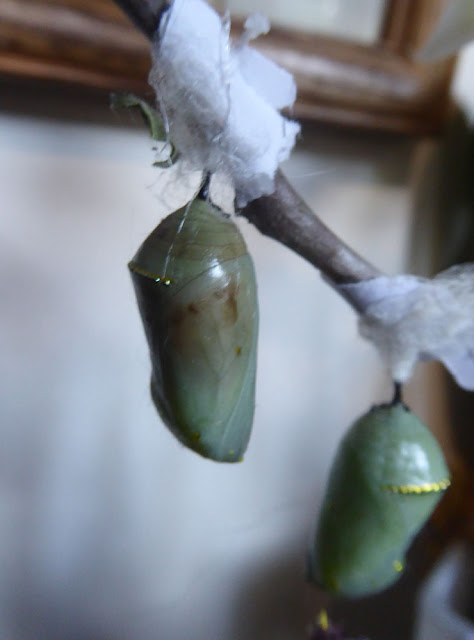This year, like every year we rescue the monarch caterpillars off the milkweed that grows on the edge of the road before the county movers come through and mow it all down. We were able to save and release 17 healthy monarchs this year.
However, not all of our caterpillars survived. In nature only 1 out of every 10 eggs survived to maturity. There are many diseases and parasites that can kill them. Our very first chrysalis this year began turning weird colors, so i knew it was dead. i was worried at first that it may have had a virus and all of the caterpillars i had would have been exposed to it, but then i saw the hole in the side and the weird little larva on the bottom of the container and i knew it had just been infected by a Tachnid fly.
Thankfully, the other caterpillars we fine and went on to become butterflies.
i like to move the chrysalis out of the container so they don't get damaged by the remaining caterpillars, or from opening and closing the lid to refill the milkweed.
The last batch of monarchs i collected, looked a little odd. It's hard to tell in the photo, but the black and white lines did not have clear borders. The black looked like it had bled a bit into the white, or like the lines were made with water colors. They just looked a little off, so i isolated them from the rest. They continued eating like normal, and then transformed into their chrysalis. So i was feeling optimistic, that maybe they were all fine.
Several days after the last of the caterpillars transformed, i saw this weird spotting. This is a sick chrysalis. It eventually turned splotchy dark and the chrysalis died. All the caterpillars with the weird stripping died in the chrysalis except one, with emerged deformed and was unable to fly.
i'm not sure what disease they had, but i suspect it may have been OE. It seems that at the end of the season, there are far more diseases than at the beginning of the season.
It always sucks to lose a few, but it's all part of the natural cycle. All of the diseased/infected caterpillars we raised had been exposed to the disease in nature and would have died anyhow. Keeping the unusual looking caterpillars isolated is important to keep viruses from spreading to healthy caterpillars, and sterilizing the containers at the end of the season is also important.
The county movers came through and mowed down the milkweed on the edge of the road, so our monarch season is officially over. i still see a few pass through, and look forward to their return next year!








0 comments:
Post a Comment